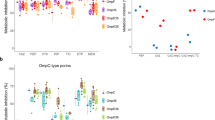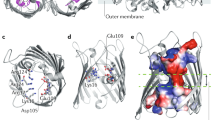Abstract
The penetration of anionic β-lactam antibiotics through porins was evaluated as a mechanism of drug resistance. The major proteins with porin activity were purified from the outer membranes of six bacteria. Three of the six porins were oligomeric porins. The molecular weights of their monomers were 37 kDa from Photobacterium damsela, 42 kDa from Serratia liquefaciens, and 36 kDa from E. coli B. The other three porins were heat-modifiable monomeric porins with molecular weights of 43 kDa from Porphyromonas asaccharolytica and Acinetobacter baumannii, and 37 kDa from Escherichia coli K12.
Comparison of the six porin proteins revealed that, independent of their aggregation state, their amino acid content is similar but not identical. All have double the amount of negatively charged amino acids compared with positively charged amino acids. They have a similar polarity and polarity index. Two of the six tested bacteria do not produce β-lactamase. These two bacteria were sensitive to the different β-lactams tested. The other four bacteria were resistant to all or to several β-lactams.
A modified liposome swelling method was used for determining the rate of penetration of charged β-lactam antibiotics. Zwitterionic β-lactams were found to penetrate into liposomes at a rate that more or less fits their molecular weight, whether the porins are monomeric or oligomeric. The penetration rates of negatively charged β-lactams are different for oligomeric and monomeric porins. Negatively charged β-lactams penetrate through oligomeric porins better than estimated by their molecular weight, whereas monomeric porins are less penetrable to negatively charged β-lactams than estimated by their molecular weight. The contribution of all types of porins to the susceptibility of bacteria to β-lactam antibiotics (zwitterionic or negatively charged) is apparently doubtful. The porins may decrease or increase bacterial penetration rates to β-lactams, and only the existence of a potential β-lactamase that can destroy the penetrating drug will cause resistance.
Similar content being viewed by others
Author information
Authors and Affiliations
Additional information
Received: 28 January 2002 / Accepted: 4 May 2002
Rights and permissions
About this article
Cite this article
Nitzan, Y., Deutsch, E. & Pechatnikov, I. Diffusion of β-Lactam Antibiotics Through Oligomeric or Monomeric Porin Channels of Some Gram-Negative Bacteria. Curr Microbiol 45, 0446–0455 (2002). https://doi.org/10.1007/s00284-002-3778-6
Issue Date:
DOI: https://doi.org/10.1007/s00284-002-3778-6




